Green Dot Stock: Earnings Rate and Fintech Growth Potential (NYSE:GDOT)

Viorika
Green dot (NYSE:GDOT) is one of the oldest financial technology companies operating as it was founded back in 1999, just before the dot com bubble popped. The company has gradually evolved its business model as its ‘banking as a service’ offering a great solution for other technology companies. Green Dot reported solid financial results in the third quarter of 2022, when it beat both top- and bottom-line financial estimates. In this post I will dive into the business model, economics, valuation, let’s dive in.
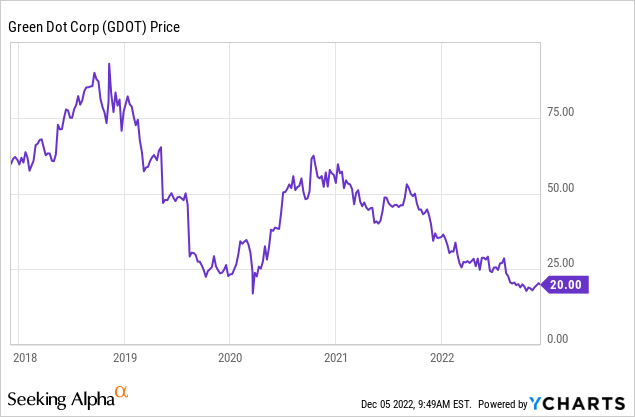
Evolving business model
Green Dot is a rather unique fintech company as they are also a registered bank. The majority of Fintech companies do not have a banking license and must work with established banks for loan services. This means that Green Dot is in a rather unique position which acts as a competitive advantage in the market.
The company was a pioneer in prepaid debit cards such as those used by Walmart with its “Money Card” and Turbo Tax with its debit card. However, the company has also helped launch a number of co-branded card programs such as those with Citibank and A&T. Since Green Dot is a bank of record, it can link its card programs with traditional bank accounts like the 2% savings account offered with Walmart.
Green Dot Prepaid Debit Cards (Green Dot)
Green Dot leverages its unique market position to offer a “Banking as a Service” solution to major technology companies such as Apple ( AAPL ) with Apple Pay Cash, Uber ( UBER ) and even Amazon ( AMZN ).
The global Banking as a Service industry was valued at $2.41 billion in 2020 and is projected to grow at a rapid 17.1% CAGR, reaching $11.34 billion by 2030.
In addition, the company offers a “Money Movement” Services segment that helps with payment processing and tax refund processing. The business has 13 issued patents across the technology which also serves as another competitive advantage.
Stable economy
Green Dot reported solid financial results for the third quarter of 2022. Revenue was $337 million for the third quarter of 2022, which beat analysts’ expectations and rose 1% year over year.
Income (Q3.22)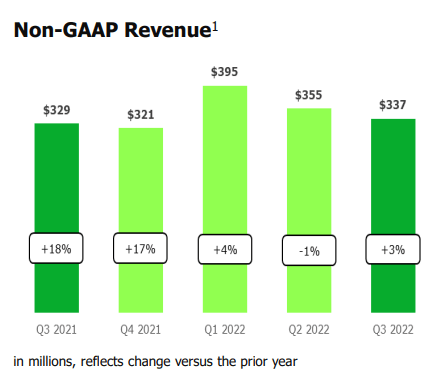
This relatively flat revenue was driven by the combined performance of various business segments. For example, Consumer Services revenue fell 19% to $136 million. This was mainly driven by a 17% decline in purchase volume to $4.3 billion, as consumers cut back on spending. These results may look a little worse than they are, as the economy is up against a tough comparison after the strong boom in spending and direct stimulus provided in 2020 and 2021. For example, many consumer accounts are benefiting from improved pandemic-related unemployment benefits that were evident in much of the third quarter of 2021. Its retail channel has been negatively impacted by declining in-store foot traffic, following a boom during the 2021 “reopening.”
One positive is that the income per average active account has surprisingly increased by 13% from year to year. This was driven by a better mix of customer accounts, as many of those who used the platform for a stimulus deposit have left. Its current customers are also adopting additional features such as overdraft protection.
Declining purchase volume Consumer segment (Q3.22 report)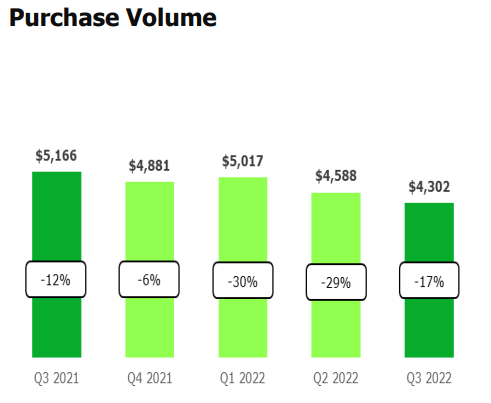
The B2B segment of Green Dot’s business reported strong growth with revenue increasing by a rapid 34% year-on-year. This segment includes its modern “Banking as a Service” (BaaS) solutions and PayCard channels. The beauty of Green Dot’s platform is that it grows with the customer’s payment volume. The company reported strong growth in volume for one of its “major customers”, which I’m guessing might be Uber based on the latest earnings for the business.
Segment revenue B2B (Q3.22 report)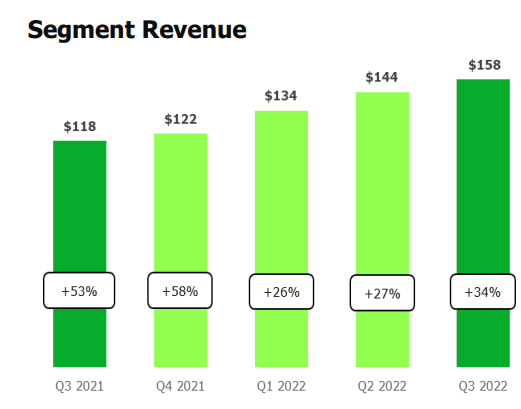
Green Dot’s “Money Movement” business reported revenue down 17% year over year to $38 million. This was driven by a reduction in stimulus-related compared to the previous year. In addition, the business has experienced a “normalisation” of the tax season. Positive for the business is that interest income on savings accounts increased by a staggering 217% year-on-year, thanks to rising interest rates.
Cash flow income (Q3.22)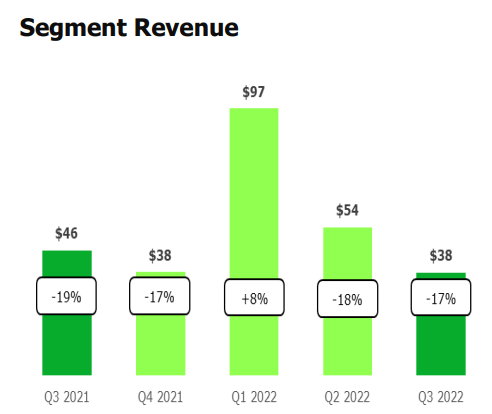
In terms of profitability, the company reported $7.3 million in net income, which was down 36% year over year. Earnings per share were $0.09, down 31% but beating analyst estimates by $0.05. The general decline in earnings was a result of the aforementioned trends. The main contributors to the decline were Consumer Services, which reported a 10% decline in revenue to $54 million. In addition to Money Movement services, which reported a 22% decline in revenue to $15 million, driven by the aforementioned “tax normalization.” On a positive note, B2B segment earnings increased 21% year-over-year to $22 million, as the business benefited from growth in its underlying customers.
Green Dot has a strong balance sheet with $92 million in unrestricted cash in the overall holding company, which does not include customer funds. As well as total debt of just $9.7 million, although this calculation may be slightly skewed as Green Dot is technically a bank.
Management showed confidence when they bought back 1.3 million shares at an average price of $22.92 in Q3.22. The company also has 16 million dollars left of the authorization to buy back shares.
Advanced valuation
To value Green Dot, I plugged the latest economics into my advanced valuation model that uses the discounted cash flow method of valuation. I have forecast a conservative 5% revenue growth for next year due to the tough macroeconomic environment. However, in years 2 to 5, I have predicted faster revenue growth of 12% per year as the B2B business continues to grow.
Green Dot stock rating 1 (created by author Ben at Motivation 2 Invest)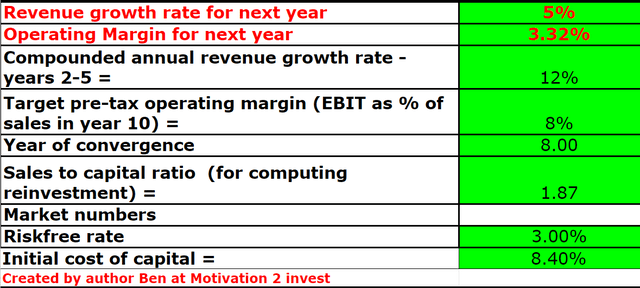
I have also predicted that the business will grow its operating margin to 8% within 8 years, as segment profitability from the B2B business makes up a larger portion of the bottom line.
Green Dot stock rating 2 (created by author Ben at Motivation 2 Invest)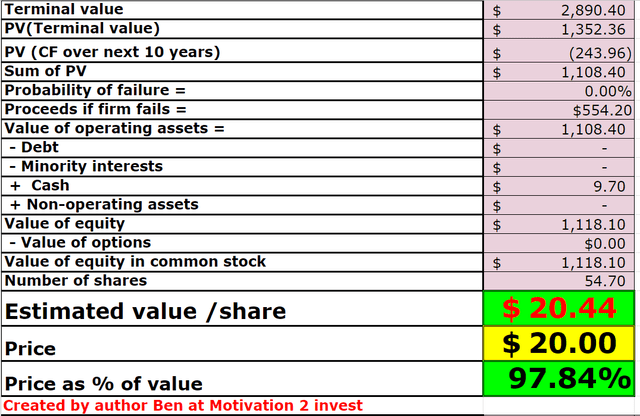
Given these factors, I get a fair value of $20 per share, the stock is trading close to this at the time of writing and is thus “fairly valued”. As an additional data point, Green Dot has a non-GAAP PE ratio = 8 which is 53% cheaper than the 5-year average. Relative to its fintech industry peers, Green Dot trades at a cheap PS ratio = 0.745, as you can see in the chart below.
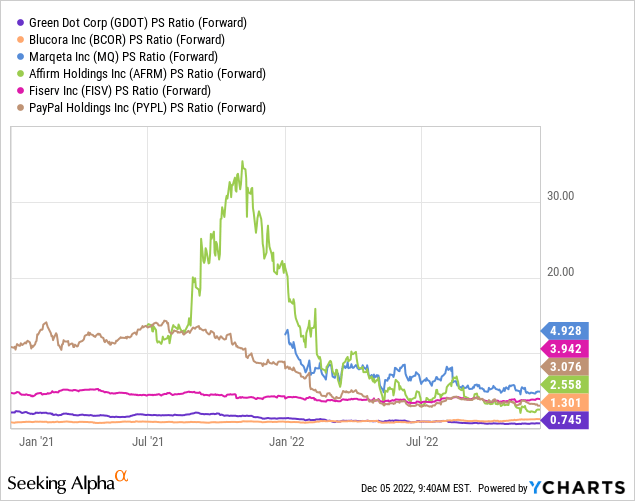
Risks
Lower payment volume/recession
The high inflation and rising interest rate environment has led many analysts to predict a recession. A recessionary environment often results in lower consumer spending, which is bad news for fintech companies.
Final thoughts
Green Dot is an interesting fintech company that is uniquely positioned to serve multiple markets thanks to its banking license and reputation. The company delivered stable financial results in the third quarter and the B2B segment is growing well. The stock is reasonably valued at the time of writing and undervalued in itself, so it could be a great long-term investment.

























